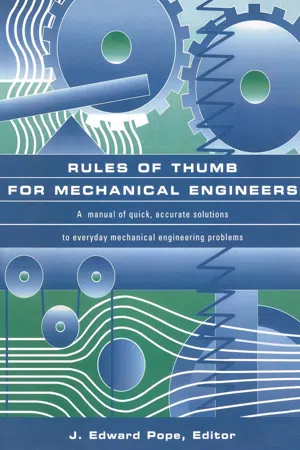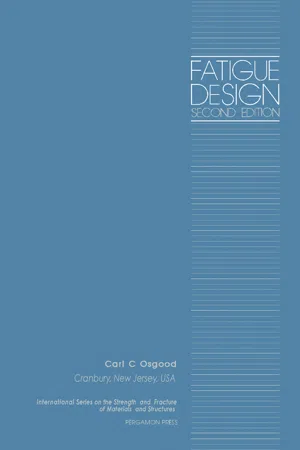Technology & Engineering
Fatigue Chart
A fatigue chart is a graphical representation of the relationship between stress and the number of cycles to failure for a material. It is used to predict the fatigue life of a material under cyclic loading conditions, helping engineers and designers understand how materials will perform over time and enabling them to make informed decisions about material selection and design.
Written by Perlego with AI-assistance
Related key terms
1 of 5
5 Key excerpts on "Fatigue Chart"
- eBook - ePub
- Dan B. Marghitu, Mihai Dupac(Authors)
- 2019(Publication Date)
- Butterworth-Heinemann(Publisher)
Chapter TwoFatigue failure
Abstract
The failure of a component of a mechanical system under the engagement of oscillating stresses between some limits is defined as fatigue failure. This chapter analyzes the endurance limit, modifying factors, and also fluctuating stresses. The fatigue life for different loads and the variable loading failure theories are also considered and the constant life fatigue diagram is drawn. MATLAB is an excellent tool to develop analytical and numerical results, as well as to generate graphical representations for SN and constant life fatigue diagrams.Keywords
Fatigue life; Endurance limit; Modifying factors; Fatigue diagramsRepeated, alternating, or fluctuating stress is a stress oscillating between some limits acting on a component of a system. The fatigue failure is a breakdown of the part under the action of these alternating stresses. A small crack will be sufficient to initiate fatigue failure. There are two distinct ways of a part failing due to fatigue, either a gradual growth of a crack or based on the rapid fracture of a system component.2.1 Endurance limit
A Moore's fatigue testing machine rotates a test specimen with a constant angular speed. The test specimen is in pure bending under different weights. The fatigue strength, also called endurance strength, is the maximal reversed stress the material can withstand without failure for a considered number of cycles. For every experiment the endurance/fatigue strengths are represented as functions of the matching number of revolutions. The obtained graph known as the Wohler diagram represents the foundation of the strength-life method and depicts the nominal stress amplitude S versus the number of cycles N. The S–N diagram is usually presented on a log–log scale.The fatigue or endurance limitS e ′of a test specimen (Fig. 2.1 ) for ferrous materials is the extreme value of the alternating stress that can be endlessly endured with no failure. The fatigue limit of the test specimen is represented with a horizontal line on the S–N diagram, as shown in Fig. 2.2 - Anastasios P. Vassilopoulos(Author)
- 2019(Publication Date)
- Woodhead Publishing(Publisher)
1Fatigue life modeling and prediction methods for composite materials and structures—Past, present, and future prospects
Anastasios P. Vassilopoulos Ecole Polytechnique Fédérale de Lausanne (EPFL), Composite Construction Laboratory (CCLab), Lausanne, SwitzerlandAbstract
This chapter aims to provide an overview of the fatigue life modeling and prediction methods for composite materials and structures, recalling methods used in the past, discovering the present status, and attempting to foresee future trends.Keywords
Fatigue; Composites; Life prediction methods; Constant amplitude loading; Variable amplitude loading; S -N curves; Residual strength; Residual stiffness1.1 Introduction
One of the first fundamental facts of which human being becomes aware of is that nothing lasts forever. Life may come to a sudden end or last longer, but still for only a finite period. This latter case is normally supplemented by a reduction in efficiency, known as aging. This human life experience is directly reflected in materials science; under a high load, a structure or a component can fail at once, whereas it can effectually sustain lower loads. On the other hand, the same structure or component can also fail under lower loads if they are applied over longer time frames in a constant (creep) or alternating (fatigue) way. The phenomenon of the degradation of properties of a material due to the application of loads that fluctuate over time is called fatigue and the resulting failure is called fatigue failure. Independent of the material, fatigue is caused due to time-varying stresses, below the material strength. Fatigue is localized at geometrical/material discontinuities and fatigue failure is a sequence of events including damage initiation (crack for metals, crack(s), delaminations, and other damage types for composites) damage propagation and final fracture.Fatigue was identified as a critical loading pattern a long time ago by the scientific community. The first manuscript where fatigue was referred to is probably the book written in 1841 by Jean-Victor Poncelet, a French mathematician and mechanical engineer. In that book entitled “Introduction à la méchanique industrielle physique ou expérimentale” Poncelet mentioned that any spring subjected to a push-pull force will, eventually, break under a load which is far smaller than the static breaking load [1] . He was the first one to address the term fatigue to describe this phenomenon. In the English language, the term has been introduced in 1854 by the British Engineer F. Braithwaite in his paper “On the fatigue and consequent failure of metals” in the proceedings of the Institution of Civil Engineers (ICE) [1]- eBook - ePub
The Theory of Critical Distances
A New Perspective in Fracture Mechanics
- David Taylor(Author)
- 2010(Publication Date)
- Elsevier Science(Publisher)
CHAPTER 9Fatigue
Predicting Fatigue Limit and Fatigue Life
Publisher Summary
Fatigue is by far the most common cause of mechanical failure in engineering components. The prevention of fatigue failure is a major preoccupation of designers in many industries, such as power generation and transport. Fatigue cracks usually initiate at stress concentration features and such features are almost inevitable in the design of engineering components. The ability to predict the effect of stress concentrations on fatigue life and fatigue strength is crucial in engineering design; any improvements in prediction methods will inevitably prove beneficial for more efficient design and reduced incidence of failure. In a component with no long crack, there are three commonly used methods for predicting fatigue life: the stress-life method, the strain-life method, and fracture mechanics. The stress-life method involves estimating the local stress amplitude and R ratio in the region of the feature, where stresses are highest; and estimating the total number of cycles to failure, Nf , using data in the form of an S/N curve generated from standard test specimens. The strain-life method works similarly, except it uses strain at the notch. This method is often called the “local strain approach.” The alternative method for assessing notches and other such features is the fracture mechanics approach involving crack propagation in both the short and the long-crack stages. The chapter also discusses the use of the theory of critical distances (TCD) and some other methods for predicting the fatigue limits of bodies containing notches or cracks.9.1 Introduction
Fatigue is by far the most common cause of mechanical failure in engineering components; the prevention of fatigue failure is a major preoccupation of designers in many industries, such as power generation and transport. When fatigue occurs in critical components (Colour Plate 4 - eBook - PDF
- J. Edward Pope(Author)
- 1996(Publication Date)
- Gulf Professional Publishing(Publisher)
347 Evaluation of Failed Parts .............................................. 347 Nonmetallic Materials ............................................. 348 Fatigue Testing ......................................................... 349 Liability Issues ......................................................... 350 References ................................................................. 350 329 330 Rules of Thumb for Mechanical Engineers INTRODUCTION Fatigue is the failure of a component due to repeated ap- plications of load, which are referred to as cycles. An ex- ample of fatigue failure can be generated using a paper clip. Bending it back and forth will cause failure in only a few cycles. It has been estimated that up to 90% of all design- related failures are due to fatigue. This is because most de- sign problems are worked out in the development stage of a product, but fatigue problems may not appear until many cycles have been applied. By this time, the product may al- ready be in service. In the 1840s, the railroad industry pushed the limits of engineering design, much as the aerospace industry does today. It was noted by those in the field that axles on rail- road cars failed after repeated loadings. At this time, the con- cept of ultimate stress was well understood, but this type of failure was clearly something new and puzzling. The phe- nomenon was termed fatigue because it appeared that the material simply became tired and failed. August Wohler, a German railroad engineer, performed the first thorough investigation of fatigue in the 1850s and 1860s. He showed that fatigue life was related to the applied load. The basic principles discovered by Wohler are still valid today, although much additional knowledge has been gained. Many of these lessons have been learned the hard way. Some of the more notable fatigue problems include: 9 World War II liberty ships, which sometimes broke in half. - eBook - PDF
Fatigue Design
International Series on the Strength and Fracture of Materials and Structures
- Carl C. Osgood, D. M. R. Taplin(Authors)
- 2013(Publication Date)
- Pergamon(Publisher)
2. Evaluation of what, if any, statistical quantities are to be presented along with the A and B values. 3. The accumulation of fatigue data in statistically meaningful quantity. In the past, fatigue properties have been shown in the form of typical S-N (stress vs. cycles of lifetime) curves for available testing conditions. As more data become available, these are being replotted as modified Goodman, or constant life-time, diagrams to allow interpolation to the exact loading conditions required. The data could be presented as average curves or as curves of some stated proba-bility of survival. As a practical matter, the constant lifetime diagrams so far have presented average curves, since available data generally are insufficient for meaningful statistical analysis. Likewise, creep data in the past have been shown as typical stress-time curves for various values of strain. Several empirical creep equations are now being studied for the purpose of combining data for various stresses, strains, times, and temperatures, and presenting these in a simple creep nomograph. Boundaries of failure band 1% and 9 9 % cumulative failure probabilities Distribution of stress at a given No. of cycles to failure N,, Distribution of cycles to failure at constant stress S., General Factors 445 As this effort proceeds, probability criteria will undoubtedly be added, subject, however, to the same potential limitations that exist for fatigue data. Fracture toughness indices (K c , K lc , J c , etc.) have not yet been included in MIL-HDBK-5. Much of the delay can be attributed to the lack of agreement on how to determine these indices and how to use them in design. At the present time, it appears that reliable and useful K lc values can be provided for selected alloys and products. These will be termed indicative or typical values at first; however, these indices may soon be brought under the classification of design allowables.
Index pages curate the most relevant extracts from our library of academic textbooks. They’ve been created using an in-house natural language model (NLM), each adding context and meaning to key research topics.




